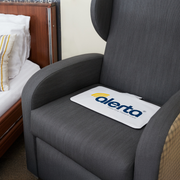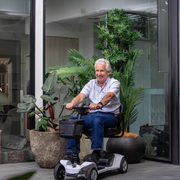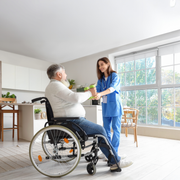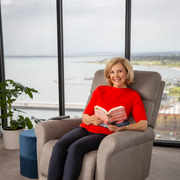- Home
- /
- Buyer's Guides
- /
- Buyer’s Guide to Falls Prevention

Buyer’s Guide to Falls Prevention
24 February 2025
Date Posted: 3 May 2021
How to reduce the risk of falls for older people at home
Slips, trips and falls can happen to anyone. But for older people, experiencing a fall can have serious consequences. Putting in place a strategy to reduce the risk of falls can help to maintain independence at home.
Falls prevention at home can involve a range of steps, involving not only the older person, but also other occupants of the home, carers and occupational therapists. It can mean making changes to the home environment and even adding mobility aids to reduce the risk of falling or minimise harm if a fall does occur.
In this guide, we’ve outlined some of the things to consider when it comes to falls prevention at home.
Why does falls prevention matter?
At least 1 in 3 people over 65 will experience a fall every year. And falls are the leading cause of injury-related hospitalisations for over 65s.
While not every fall results in serious injury, even a minor fall can cause:
- bruising and sprains
- abrasions and cuts
- fractures and dislocation
- a loss of confidence that can lead to reduced activity or mobility
With nearly 2 in 3 falls happening in and around the home, putting in place a falls prevention plan is essential to prevent injury and maintain independence.
Leading causes of falls
Deteriorating health as a result of ageing increases the risk of a fall. This can be due to a range of changes in the body, such as:
- Poor eyesight which can lead to problems judging depth or distance, or difficulty making out shapes (especially in dark rooms or areas)
- Weaker muscles, stiff joints and balance issues which make it difficult to walk, stand and navigate steps
- Reduced circulation in the legs and feet leading to reduced mobility and connection with the floor
- Slower reaction times and difficulty concentrating on two or more tasks at once.
Often a fall is one of the first signs that a person’s health may be declining. This is because many of the signs of ageing happen gradually over time. It’s only when a fall or near miss happens that these issues can become apparent.
Be on the lookout for any changes, however minor, that could increase the risk of a fall. It might be something as minor as missing the edge of a table when placing a cup down or finding it difficult getting out of bed. Even frequent stumbles or ‘near misses can reveal an increased risk of falling later.
If someone has experienced a fall in the last 6 months, they are more likely to fall again.
Reducing the risk of falls
There are a number of things that you can do to reduce the risk of falling at home. These include:
- Identifying hazards around the home and making modifications
- Staying healthy and keeping up to date with check ups
It’s also important to have a plan in place in case a fall does occur.
Safety at home
One of the practical things that you can do to reduce the risk of falls at home is to make some simple modifications in three key areas:
- Lighting
- Tripping
- Slipping
Lighting
Poor lighting makes it difficult to see where you’re going and identify potential trip hazards.
- Replace low light bulbs with a higher wattage.
- Install motion-activated lights at entryways and in hallways.
- Use solar-powered lights along garden paths.
- A glow-in-the-dark frame around light switches helps to make them easy to find at night.
- Apply glow-in-the-dark tape to help identify hazards or objects to be aware of.
Tripping
Even the smallest things can become a trip hazard. Take a walk through the house and look out for:
- Rugs or carpet lifting at the edges – tape these down with double-sided tape or remove entirely
- Electrical cords running across pathways – move behind furniture or along skirting boards
- Clutter and low tables – put items away, remove small pieces of furniture and use an arm rest caddy to hold books, glasses and remotes
- Steps, uneven paving and level changes – mark these using contrasting tape along the edge
- Pets – add a bell to their collar and look out for them before walking
Slipping
Slippery surfaces and inappropriate footwear can easily lead to a fall. Simple changes can include:
- Wear well-fitting, comfortable flat shoes
- Use non-slip mats in the bathroom, shower and other wet areas
- Install handrails in the shower or bath
- Keep pathways clear of leaves and grass clippings
- Clean up spills as soon as they happen
Staying healthy to prevent falls
Staying fit, moving regularly and checking in with your healthcare providers are all things that you can do to prevent the risk of a fall.
Chronic diseases like arthritis, Parkinson’s disease, Alzheimer’s disease, changes resulting from a stroke or diabetes can increase your risk of falling. Other issues like poor eyesight, injury and short-term illness can also contribute to an increased risk of falling.
Make sure that you’re having regular check-ups with your doctor to discuss any concerns, however minor. Keep a note of any trips or near misses that do occur, including when, where and how they happened, so that you can chat with your doctor about potential lifestyle changes.
Have regular appointments with your optometrist to check in with your eyesight. If you do require glasses, make sure that you have them with you – a chain around your neck can help. When moving from a light to dark room (or vice versa) take a moment to allow your eyes to adjust before walking around.
Low blood sugar, dehydration and tiredness can all lead to a higher chance of falling. So eat lots of fresh food, drink plenty of water and get a good night’s sleep. Speak with your doctor about potential supplements that may be missing from your diet.
Frequent moderate exercise and moving regularly can also help to prevent a fall. People who are inactive tend to have weakened muscles and poorer balance, which leads to unsteadiness when walking. Aim for at least 30 minutes of moderate exercise 3-5 times a week. This can be a mix of walking, stretching, group exercise classes, dancing or any activity that gets you moving.
You can also do specific strengthening exercises designed to build your muscles and improve balance.
Strengthening exercises to prevent a fall
These are some simple exercises you can do daily to improve your strength and balance. For more specific exercises, speak with your doctor or occupational therapist.
Heel raises
Stand with hands resting gently on a kitchen bench or sturdy chair (for support) and slowly lift your heels off the floor. Hold at the top then lower to the floor. Repeat 10 times.
Side leg lifts
Stand with legs together and your hands resting on a bench or chair. Slowly shift your weight to one leg as you lift the other leg out to the side. Return to the starting position and repeat with the other leg. Repeat 5 times on each leg.
Walking heel to toe
Standing next to a wall (for safety), place your right foot directly in front of your left foot so that the heel touches the toe. Then step the left foot in front of the right, again with heel to toe. Focus on pressing through the foot from heel to toe and maintaining your balance. Repeat for 20 steps.
Sit to stand
A simple exercise that improves strength and stability. Sit down on a sturdy chair or bench with arms crossed in front of you. Stand up slowly, focusing on pressing through your heels and using your thighs and glutes. Sit back down slowly and repeat a few times. For an easier option, hold your arms out in front or use a chair with arms to support you.
Make a plan in case of a fall
While you want to do all that you can to prevent a fall, it’s also important to have a plan in place if a fall does occur. Lying on the floor unable to get up can lead to problems such as dehydration, pressure sores, hypothermia and delayed medical assistance.
If you live alone, it’s important that you get help quickly if you have a fall or another emergency.
A personal alarm will allow you to contact a friend or family member who can get help on your behalf. Options include:
- Wearable device that can attach to your wrist, around your neck or on your waistband
- Wearable device (such as a smart watch) that can detect a fall and can call emergency services
- Intercom system activated by a voice command
- Monitored alarm system
- Having a daily check-in system
Make sure your contact person knows how to access your house if the door is locked – consider having a lockbox or leaving a key with a neighbour.
Falls prevention products
High-Low beds
Issues with balance and mobility can make getting out of bed difficult. High-low beds make transitioning in and out of bed easier. These adjustable beds provide a gradual and supported way to transition from lying down to standing.
The ComfiMotion adjustable beds provide all the features expected of an adjustable bed, including hi-lo positioning, back and leg raise, and zero gravity. Using the various settings, the user can lift themselves into a seated position and then transfer to the floor safely. The modern design fits with any decor and the ComfiMotion Activ Care bed also comes with a built-in massage function and battery backup, while the ComfiMotion Care bed includes a press and hold safety handset to enhance usability. The ComfiMotion bed also has a night light feature to make it safer when getting up to use the toilet at night.
The Aspire Lifestyle Community Bed is a simple yet functional bed that offers a unique, transportable design. The optional side rails help prevent rolling out of bed and can be easily lowered out of the way when needed. The attached handset allows the bed to be adjusted by both the user and their carer to find the best position for sleeping, activities and transfers.
Bathroom Accessories
The bathroom is one of the most common areas in the home for a fall to occur resulting in hospitalisation. The combination of a confined space, hard surfaces and slippery areas can lead to serious injuries.
Installing bathroom aids can help with balance while moving around the bathroom and carrying out daily activities such as bathing and using the toilet.
Showering is made easier and safer with a shower chair or shower stool. These both provide a sturdy place to sit while washing and drying off. The sturdy frame also helps with balance, providing something to lean on while getting in and out of the shower.
A toilet seat surround offers a sturdy frame to lean on for balance and take the pressure off the legs and lower back.
Similarly, a toilet seat raiser lifts the height of the toilet to reduce the effort required to stand.
For more on bathroom safety, including falls prevention and bathroom aids, head to our online guide.
Lift Chairs
A lift chair provides assistance to anyone who has difficulty transitioning from a seated to standing position. With touch of the button the chair gently rises and tips forward allowing the user to step out with ease and avoid undue muscle strain.
The ability to nearly fully recline a lift chair also makes it an ideal place to rest during the day, elevating the legs to improve circulation and find a comfortable position that takes the strain off the hips and back.
You can read more about the benefits of lift and recline chairs in our online guide.
Touch Lamps
Not only is fumbling around in the night looking for a light switch frustrating, it can also increase the risk of falling out of bed. Touch lamps are a simple solution to illumination issues, making it easy to simply reach out and switch on the light before getting out of bed.
Falls Prevention Summary
There are a number of things to consider when it comes to choosing any mobility aid. Getting expert advice can help you compare options and make an informed decision. The team at Aidacare are experts when it comes to falls prevention and can walk you through the different options available.
Browse the full range of falls prevention equipment available from Shop Aidacare.







